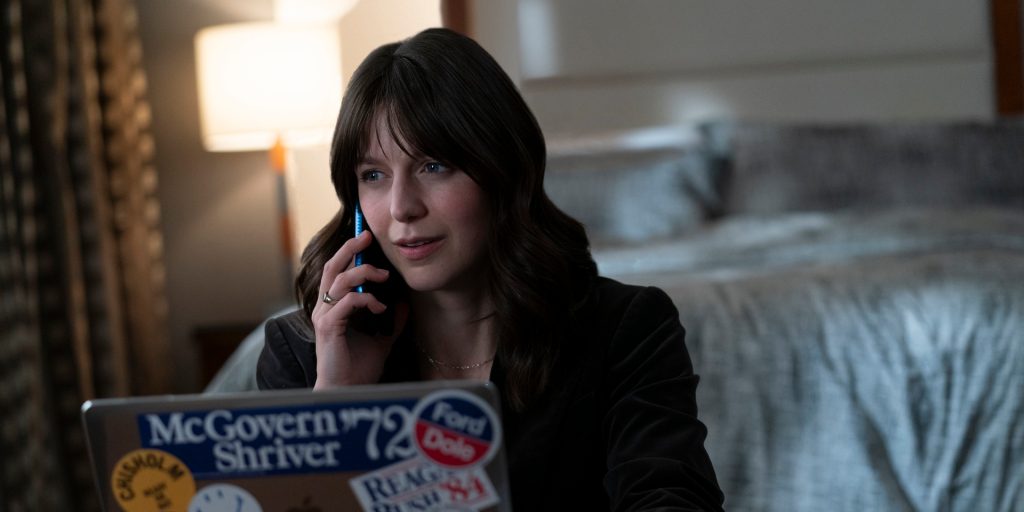Created by Julie Plec and Amy Chozick, Max’s ‘The Girls on the Bus’ is a drama centered around four women who embark on covering a presidential candidate’s campaign. The narrative commences with Sadie McCarthy, a journalist who passionately pleads with her editor for the opportunity to join the campaign trail of presidential frontrunner Caroline Walker. Along her journey, she encounters three other women with markedly diverse backgrounds and perspectives, all united in their pursuit of the same story.
Among the trio of additional women, Grace stands out as a seasoned journalist, Kimberlyn represents the conservative news sector, and Lola emerges as a survivor of a mass shooting who has transitioned into a social media influencer, leveraging her platform for causes close to her heart. Despite their apparent disparities, this eclectic group discovers an unexpected bond of camaraderie and companionship, realizing that beneath their varied backgrounds and perspectives, they share a common desire for something greater. In this very real-life setting, it will be interesting to find out if the story has some true-to-life connections or not.
Real-Life Elements That Inspired The Girls on the Bus
The story of ‘The Girls on the Bus’ draws inspiration from a segment of co-creator Amy Chozick’s book titled ‘Chasing Hillary: Ten Years, Two Presidential Campaigns, and One Intact Glass Ceiling.’ Published in 2018, Chozick’s book chronicles her personal experiences covering Hillary Clinton’s presidential campaigns in 2008 and 2016. As she penned her book, Chozick envisioned adapting it for the screen. Collaborating with producers Greg Berlanti and Sarah Schechter, they identified the chapter titled ‘The Girls on the Bus’ as a focal point for the series. Then, together with co-creator Julie Plec, Chozick started developing the storyline. Apart from this aspect, the series is detached from reality.

It unfolds in a contemporary fictional realm where a fictitious presidential candidate campaigns and the creators invented these four female characters from scratch. Nevertheless, these women serve as proxies for genuine individuals in society, embodying various societal subsections. They effectively represent different segments of society, echoing the diversity of perspectives and experiences found in real life. Talking about the writing process of these characters, Plec said, “But when we settled on making it a show about the kind of found family that develops in a bus-tour-across-the-country circumstance, we just had to ask ourselves, Okay, well, we don’t want the bus to be full of a bunch of women that just look like us and sound like us and think like us.”
Plec concluded, “So let’s start figuring out who these women are.” The character of Lola emerged from the creators’ recognition of the rising influence of young activists entering the political arena, particularly in the wake of events like the Parkland school shootings. They took into account the impact of vocal activists who emerged from such tragedies, including prominent figures like X González (born Emma González). Additionally, they sought to incorporate a more seasoned perspective into the narrative, leading to the creation of the character of Grace.
To ensure a diverse range of voices in the series, the creators recognized the importance of including a conservative perspective, which they achieved through the character of Kimberlyn. Giving more insights about the characters of Kimberlyn and Amy, Plec added, “And we said, ‘Well, who would have every right to be a fiscal Republican in this world if we took certain people out of the equation? They would be a very, very smart black woman.’ So then we went down a deep dive of trying to shape who Kimberlyn was going to be. We had a good time coming up with all these characters, knowing that Sadie was a blend of Amy and me and women heroines that we love.”
The series adeptly portrays the backdrop of these women operating within a presidential campaign trail, offering a candid glimpse into the world of journalism. Rather than romanticizing it, the series presents it as it truly is. From mundane turkey sandwiches to enduring bus breakdowns and repetitive hotel stays, the series authentically captures the daily realities of the job. Chozick even commended the authenticity of the props, noting that the press pass to the DNC (Democratic National Committee) made by the props team was quite identical to the real one.
Although set in a fictional world, ‘The Girls on the Bus’ raises pertinent questions and explores themes deeply relevant to modern-day journalistic practices. It engages audiences in thought-provoking discussions about the state of contemporary journalism and the responsibilities of media professionals in an era of rapid technological advancement and political polarization. Inviting reflection on the impact of media coverage on shaping public opinion and political discourse, the series makes for quite a relevant and refreshing watch.
Read More: The Girls on the Bus: Where is the Max Show Filmed?


You must be logged in to post a comment.